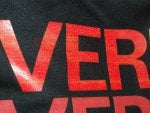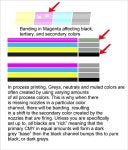I've been struggling with our HM1 to try and reliably print an image for a while now. I'm using the colour-accurate ICC profiles from our distributor, and I'm printing with 1440x1440 for both whitebase and colour. Using Print Pro DTG Edition.
The print is on a black shirt, using the Wagner handheld to pretreat. Heatpressing for 10 seconds @ 340, spraying with pretreat, heatpressing for another 10 seconds @ 340, printing and then heatpressing to fix for 120 seconds @ 340.
Other colours come out fine - yellow: no problem, blue and black on other prints: no problem, and the whitebase is going fine as well.
The problem (as you can see in the photos) seems to be many very small lines, which cluster together to give the appearance of banding when viewed from more of a distance. The spacing between the lines would indicate a print head-related problem? Although again, I'm not 100% sure if this is the root cause.
To try and get rid of it in the print, I've tried all sorts - increasing the colour boost to 20% then 25% (which does improve the print, but doesn't get rid of the problem completely), tried two passes of colour at 1440x720 after a 1440x1440 whitebase... I just can't get this right.
sample image (print at 1440x1440), no colour boost:
http://www.t-shirtforums.com/attachment.php?attachmentid=10926&stc=1&d=1253641344
First impressions for me are that it's either a problem with our red nozzles or encoder strip... And the latter would annoy me more, since I've been looking after the machine (after the last guy who used to do it left).
I meticulously clean the print head, capping station and (when needed) the encoder strip, and I've noticed that there is a miniscule line which looks like it's been grooved into the encoder strip by perhaps the head itself as it moves back and forward while printing. Could this be causing the lines in the print?
This is seriously holding me up from getting a good print out of this image, so any and all help/advice is appreciated! For the life of me, having tried everything I can think of, I'm still no nearer to actually fixing this problem (only a colour boost of 25% approaches covering up the problem). We've had no end of problems with this machine but the print head itself was fairly recently replaced...
Cheers!
Chris
The print is on a black shirt, using the Wagner handheld to pretreat. Heatpressing for 10 seconds @ 340, spraying with pretreat, heatpressing for another 10 seconds @ 340, printing and then heatpressing to fix for 120 seconds @ 340.
Other colours come out fine - yellow: no problem, blue and black on other prints: no problem, and the whitebase is going fine as well.
The problem (as you can see in the photos) seems to be many very small lines, which cluster together to give the appearance of banding when viewed from more of a distance. The spacing between the lines would indicate a print head-related problem? Although again, I'm not 100% sure if this is the root cause.
To try and get rid of it in the print, I've tried all sorts - increasing the colour boost to 20% then 25% (which does improve the print, but doesn't get rid of the problem completely), tried two passes of colour at 1440x720 after a 1440x1440 whitebase... I just can't get this right.
sample image (print at 1440x1440), no colour boost:
http://www.t-shirtforums.com/attachment.php?attachmentid=10926&stc=1&d=1253641344
First impressions for me are that it's either a problem with our red nozzles or encoder strip... And the latter would annoy me more, since I've been looking after the machine (after the last guy who used to do it left).
I meticulously clean the print head, capping station and (when needed) the encoder strip, and I've noticed that there is a miniscule line which looks like it's been grooved into the encoder strip by perhaps the head itself as it moves back and forward while printing. Could this be causing the lines in the print?
This is seriously holding me up from getting a good print out of this image, so any and all help/advice is appreciated! For the life of me, having tried everything I can think of, I'm still no nearer to actually fixing this problem (only a colour boost of 25% approaches covering up the problem). We've had no end of problems with this machine but the print head itself was fairly recently replaced...
Cheers!
Chris










